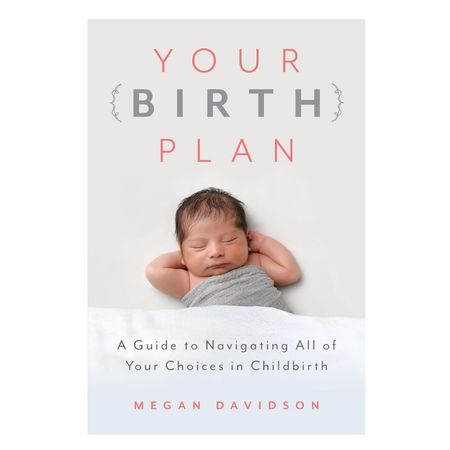
Making a birth plan doesn’t guarantee a surprise-free delivery, but at least you’ll be prepared for them. Using this helpful checklist, you may learn how to create your own birth plan.
Most expectant mothers have done study on childbirth before the second trimester and are aware that there are many different ways to tailor delivery. To record choices they might not be in a position to communicate once labor begins, patients are frequently urged to develop a formal birth plan. It’s challenging to express desires while a contraction is in progress. You have a voice throughout labor if you have a birth plan.
What Is a Birth Plan?
Writing down a birth plan enables ladies to have the labor they’ve always wanted. It resembles a personal wish list for the ideal birthing process. Birth plans were first popularized approximately 20 years ago as a byproduct of the natural birthing movement, but they are not just for mothers who intend to give birth vaginally.
Even someone who has booked a C-section has expectations for her labor and delivery. She can include in her birth plan things like whether she wants her spouse to be present during the entire process or whether she wants her baby to be placed on her chest right away.
Making a birth plan doesn’t have to be difficult; all you need is some time to think about some crucial issues related to your delivery. It enables you to pinpoint your top concerns and gets you ready to talk about them with your doctor or birth attendant.
Is a Birth Plan Necessary?
A birth plan is not necessary, but it can be a helpful way for expectant parents to communicate their preferences and wishes for the birth of their baby. A birth plan is a document that outlines the preferences and expectations of the expectant parents regarding the details of their labor and delivery. It is meant to serve as a guide for the healthcare providers who will be assisting with the birth.
Having a birth plan can be particularly helpful if you have strong feelings about certain aspects of your labor and delivery, such as your preference for pain management or your desire for a natural childbirth. A birth plan can also be helpful in ensuring that your wishes are respected and taken into consideration during the birth process.
That being said, it is important to keep in mind that birth plans are not binding and that they should be seen as a guide rather than a strict set of rules. It is also important to be flexible and open to changing your birth plan if necessary, as unforeseen circumstances may arise during labor and delivery that require you to adapt your plan.
Birth Plan Checklist
Since each labor and delivery is unique, it is beneficial to become familiar with the possibilities. Keep in mind that creating a birth plan does not ensure a painless procedure. No matter what you do, be open-minded and adventurous. This is especially true while thinking about these six crucial things to include in your birth plan checklist.
1. Where Would You Choose to Have a Baby?
Pregnant women have three major options for giving birth: a hospital, a birthing facility, or their own home.
Hospital
A hospital is where 99 percent of births take place. Find a hospital with delivery rooms if you want a more intimate situation. You can stay in these specifically designed facilities from labor till recovery, and they resemble a bedroom more than a standard delivery room.
Birthing Center
Typically, certified nurse-midwives handle the majority of the care at a birthing facility that stands alone (also known as a maternity center). These facilities are appropriate for low-risk pregnancies since they frequently emphasize low-tech delivery techniques. If problems arise, you might need to be taken to a hospital (each center has a connection to a certain hospital) for more care or emergency care.
Home
Fewer and fewer couples are choosing to give birth at home with the help of a skilled doctor or registered nurse-midwife. Only women in exceptional health who have had low-risk pregnancies—and, ideally, who have already had at least one birthing without complications—are eligible for this safe choice. In the event that a transfer to a hospital is required, backup preparations should be in place.
2. What Kind of Ideal Labor Environment Would You Prefer?
Describe the characteristics you would like your labor experience to have, such as:
• I can walk around, try different positions, etc.
• The lights are dim.
• Our favorite music is playing.
• There’s a TV.
• There’s a bath or shower available.
3. Who Do You Want With You When You Give Birth?
You might not have the strength to refuse an undesirable visitor in the delivery room when you are in the middle of labor. Name the people you want by your side throughout labor, including your partner, a labor coach, a doula, other family members, and friends. Ask whether there is a maximum number of individuals that can be in the room with you at your birthing location.
4. Are There Certain Birthing Tools or Positions That You Find Appealing?
Some women choose to give birth in a chair or birthing bed.
Birthing Bed
Nowadays, many birthing facilities offer specific beds made for both labor and delivery. Different laboring positions can be supported by raising or lowering the back. Options (which differ depending on the situation and should be explored with medical professionals) can include:
• Lying down: On your back, with your head flat or raised, and your legs raised
• Side-lying: With one leg up (this position is especially beneficial if you’re exhausted or experiencing blood pressure issues).
• Kneeling: Lying on the bottom portion of the bed while resting your arms or upper body on the top portion (this posture eases backache)
• On all fours: Supported by your hands and knees, lie on your stomach (this position takes advantage of gravity and eases backache)
• Squatting: Supported on your feet by a bed or a companion (this position takes advantage of gravity and shortens the depth of the birth canal)
Birthing Chair
Some birthing facilities feature these unique stools or chairs made specifically to support a lady when she is sitting or squatting. They enable women to take advantage of gravity and witness more of the birth, although they may result in more perineal tearing (tissue between vagina and rectum).
5. What Would Your Perfect Labor and Delivery Include?
The perfect delivery experience is influenced by a variety of elements. To choose which alternatives are most appealing to you, read the birth plan check list below.
• Continuous external fetal monitoring or intermittent external fetal monitoring (allows for movement) (usually requires you to stay in bed)
• No painkillers or strong painkillers (such as intravenous narcotics and epidurals)
• Episiotomy or no episiotomy (a perineal tissue incision beneath the vaginal opening to widen the aperture and minimize tearing). Women who choose not to have an episiotomy can relieve pain and decrease the likelihood of tears by using local massage, warm compresses, etc.
• Cutting the umbilical chord with your partner or a medical professional.
6. Which Postpartum Options Appeal You?
Plans for birth frequently include postpartum choices about the umbilical cord, the circumcision of a boy’s infant, and “rooming” with your child. To determine whether you want the birth plan alternatives, read more about them here.
Umbilical Cord Blood Donation or Banking
Previously frequently discarded, the blood in a baby’s umbilical cord is today recognized as a vital medical resource. Stem cells, which can be used to treat more than 50 disorders that are life-threatening, are abundant in cord blood. Since the blood is drawn when the umbilical cord is no longer attached, the procedure is quick, risk-free, and painless. However, you do need to make arrangements for a collection in advance because not every town has access to cord blood banks, where the collected material can be preserved.
As a form of biological insurance against potential disease in their child’s future, some parents opt to privately deposit the cord blood so that they can retrieve it in the future. The American Academy of Pediatrics advises against choosing this pricey alternative and in favor of giving the cord blood or blood stem cells to a public cord blood bank. Parents should only think about privately banking the blood if a relative is in need of or may eventually need a stem cell transplant. Consult your healthcare physician about the issue. Contact the National Marrow Donor Program for further details on cord blood donation.
Circumcision
The procedure of circumcision involves surgically removing the foreskin, which covers the penis’s tip. In the first few days following birth, the procedure is typically carried out. According to the Centers for Disease Control and Prevention (CDC), 58.3 percent of infant males in the United States were circumcised as of 2010. However, circumcision is significantly less common in other regions of the world. Even while circumcision has been linked to some health benefits, according to the American Academy of Pediatrics, these benefits are insufficient to suggest routine circumcision for all males.
For religious, societal, and cultural reasons, some parents may desire to have their sons circumcised. Others worry that circumcision lessens sexual pleasure by desensitizing the tip of the penis. Since circumcision is not absolutely necessary for a boy’s health, parents should decide what is best for their son after carefully considering the advantages and disadvantages.
Related: Circumcision | Pregnancy Birth and Baby
Rooming In:
In certain hospitals, parents are permitted to keep their infant in their room instead of the hospital nursery. Before giving birth, you can express your opinions on the matter, but you are free to alter your mind later. Following are your choices:
• Living in a room continuously starting at birth; (baby with you after an initial recovery period)
• A partial check-in (baby with you during the day, but not at night)
• Nursery (where the infant is delivered in accordance with your schedule and their needs)
Format for a Birth Plan
Be aware of the erratic character of work while you collect your thoughts. You may be adamant about holding your baby immediately away, for instance, but you should try to keep your tone friendly and non-aggressive. Each remark must begin with the phrase “All things being normal, I’d like…”
It is advised beginning with something like “I’m aware that any delivery could go in an unexpected direction. These objectives reflect my conception of a model delivery, and I appreciate your assistance in helping me fulfil as many of them as you can.”
Then highlight one or two of your most crucial goals. No matter what occurs, you can feel good about your labor by concentrating on the subjects that are most important to you.
But a successful birth plan need to be more than just a wish list; it ought to reflect your personality. If it took you nine years to become pregnant, you might write, “I’ve never been in a hospital before except when my grandma was dying, so I’m a little afraid,” or “We want every bit of technology you’ve got to ensure that our baby is born healthily.”
By letting the hospital personnel know a little about you as a person and not just a patient, they may be more inclined to support your plan.
When Is It Time to Write a Birth Plan?
Though you don’t have to put it on paper until the 32nd through the 36th week of pregnancy, you should start considering what to include in your plan as early as your second trimester. Discuss your concerns with your obstetrician or midwife, and work out any issues where you might hold divergent opinions.
Give your doctor a copy of your plan when you’ve drafted it, and set a longer-than-usual session to discuss it. Make sure the plan is included in the medical documents that are automatically forwarded to the place where you will give birth.
How Long Should a Birth Plan Be?
There is no specific length that a birth plan should be. The length of your birth plan will depend on the amount of information you want to include and the level of detail you want to provide. Some people prefer to keep their birth plan concise and to the point, while others prefer to include more detailed information.
As a general rule, it is a good idea to keep your birth plan concise and to the point. This will make it easier for your healthcare providers to read and understand your preferences. Aim for a birth plan that is no more than one or two pages long, and focus on the most important aspects of your labor and delivery that you want to address.
Is a Birth Plan a Legal Document?
A birth plan is not a legal document in the sense that it is not enforceable by law. It is simply a way for you to communicate your preferences and wishes for your childbirth experience to your healthcare provider and the hospital or birth center staff.
While your healthcare provider and the hospital or birth center staff will make every effort to honor your wishes as outlined in your birth plan, they may need to deviate from it in order to provide appropriate medical care. For example, if unexpected complications arise during labor and delivery, your healthcare provider may need to adjust your plan in order to ensure the safety of you and your baby.
It’s important to keep an open line of communication with your healthcare provider and the hospital or birth center staff, and to be prepared for the possibility that your birth plan may need to be modified based on medical necessity.
Why do Birth Plans Fail?
There are several reasons why a birth plan may not go according to plan. Some common reasons include:
- Unexpected complications: Labor and delivery can be unpredictable, and unexpected complications can arise that require adjustments to the birth plan. For example, if the baby is in distress or if the mother’s labor is not progressing as expected, the healthcare provider may need to take steps to ensure the safety of the mother and the baby, which may involve deviating from the birth plan.
- Lack of communication: It’s important to discuss your birth plan with your healthcare provider and the hospital or birth center staff in advance, and to make sure that everyone is on the same page. If there is a lack of communication or misunderstandings about your preferences, it may be more difficult to follow the birth plan as intended.
- Change of circumstances: Your childbirth preferences may change over the course of your pregnancy, or you may need to make adjustments to your birth plan based on changing circumstances. For example, you may decide to switch healthcare providers, or you may need to deliver at a different hospital or birth center due to unforeseen circumstances.
14 Free, Printable Birth Plan Templates For Every Kind Of Delivery
1. Simple Birth Plan Template

Looking for a one-page alternative that covers the basics while avoiding the rest? Truly Mama’s downloadable birth plan template focuses on essential facts about you and your delivery. The checklist contains some of the most typical birth plan choices, such as wearing your own clothing and delaying cord clamping, so you may select the options you desire and ignore the others. It also contains a section on C-section desires if you have any, because even the most basic birth plans should account for all scenarios. Color-coded sections are also a good approach to separate information for your suppliers.
2. Detailed Birth Plan Template
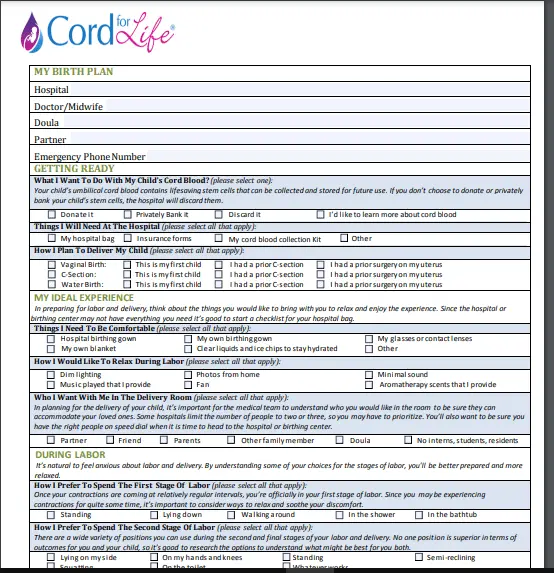
One of the main reasons birth planning may feel so daunting is all of the medical decision-making, especially if you don’t know what’s normal procedure and what you should expressly request. The Cord for Life Foundation’s downloadable birth plan contains brief summaries of what happens throughout the stage of labor and why it’s vital to consider your alternatives. It’s a good primer on the entire birth planning process.
See on Cord For Life Foundation
3. Checklist Birth Plan Template
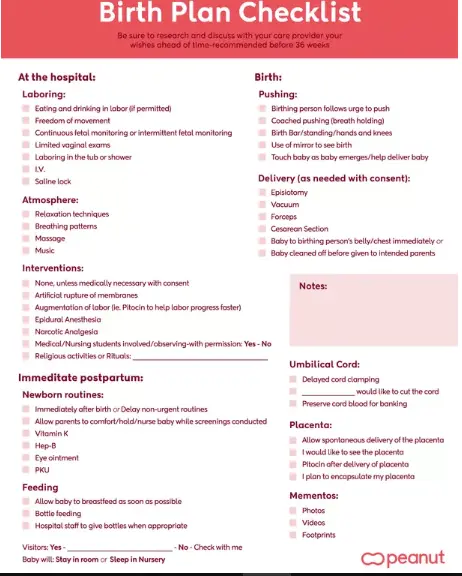
A checklist-style birth plan template, such as this one from the Peanut app, covers many common preferences, so you can simply print it out and choose the items that fit you. The parts cover each stage of your delivery — active labor, pushing, and the early postpartum period — so you can see how everything will go on the big day. This one-page, one-sided printable birth plan template is simpler for busy physicians and nurses to read in its entirety, ensuring them know exactly what’s most important to you. If something is missing from the checklist parts, it may always be added in the notes section.
4. Fill-In-The-Blank Birth Plan Template
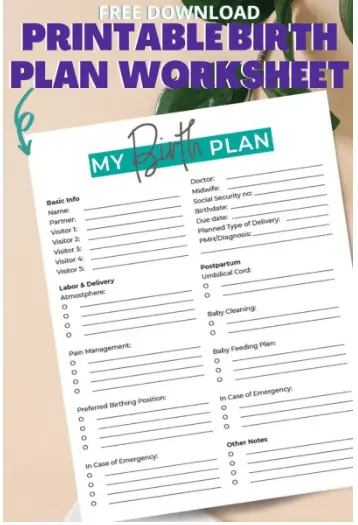
This is the template for you if you want complete control over what your birth plan says and want it to seem competent when you’re finished. The birth plan worksheet on the Savvy Mama Lifestyle site categorizes your preferences by topic (environment, pain management, and so on), but otherwise leaves the explanation of your selections up to you. Midwives, doulas, nurses, and physicians will appreciate that they won’t have to go through a large paper to see which boxes you’ve selected and which you haven’t, and that the preferences you care about will be front and center. This downloadable template is intended for individuals who understand exactly what they want. If you haven’t yet researched all of your birth plan alternatives, some of the other templates in this list may give you a better jumping-off point.
5. One Page Birth Plan Template

Do you want to put everything on one page? Motif Medical’s birth plan template is free, downloadable, and meant to be read quickly. It guarantees that everything that is important to you is communicated properly while keeping things brief and simple.
6. Visual Birth Plan Template

A birth plan that is based on pictures can appeal to you more if wordy checklists are not your thing. You may pick between downloading the Google doc or the design-forward, visually-focused birth plan template from Mama Natural that will be emailed to your email address. Once you’ve obtained the form, you may customize it to produce a lovely, printed birth plan for you and your support group. Blue emphasizes things you desire (such protecting the placenta or having quick skin-to-skin contact), whereas red denotes things you don’t want (like no episiotomy). Once the icons are arranged according to delivery stage, you have a lovely and useful birth plan that even the busiest delivery team can comprehend and use.
7. C-Section Birth Plan Template

Cesarean birth plans are, in fact, a real thing. Many hospitals will work with you to turn your anticipated C-section into the experience you want it to be, even if you might not have all of the same options as you would with a vaginal delivery. For women who have had C-sections, the clothing brand Kindred Bravely offers one of the best free printable birth plans available. It outlines alternatives you might not have been aware you have, such as choosing the music played in the operating room and requesting that any monitoring equipment be put on your back so your baby can easily be placed on your chest for skin-to-skin contact as soon as you give birth.
8. VBAC Birth Plan Template
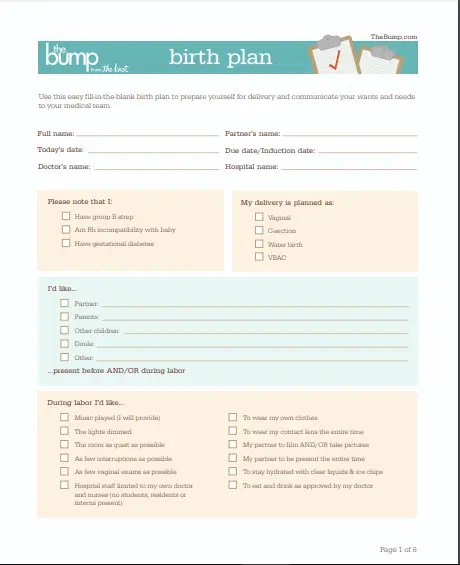
Given that giving birth is a bit of a big deal, some individuals naturally want their birth plan to be as detailed as possible. The comprehensive six-page free birth plan template from The Bump covers all the bases. It begins with a brief discussion of your medical history (particularly crucial if you have any chronic diseases), then delves into the atmosphere you want to create, includes a surprising variety of options for pain management, pushing positions, and much more. It also has an area for C-section preferences in case you need one, making it the ideal VBAC birth plan form.
9. Home Birth Plan Template
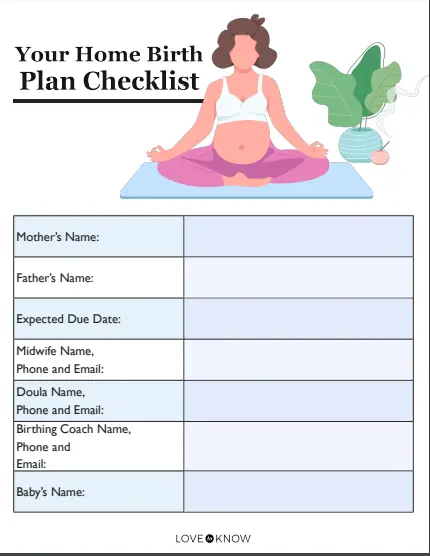
This worksheet may be exactly what you need if you want to give birth at home. It asks you questions regarding everything your home birth providers will need to know in order to get ready for the birth of your child. All of the topics covered here, including your preferred essential oils to diffuse during labor and which aspects of the delivery you do and do not want photographed, are likely to be discussed with your midwife throughout pregnancy. However, having a written birth plan can help you feel calmer throughout labor since it lets those close to you know precisely what you want.
10. Hospital Birth Plan Template
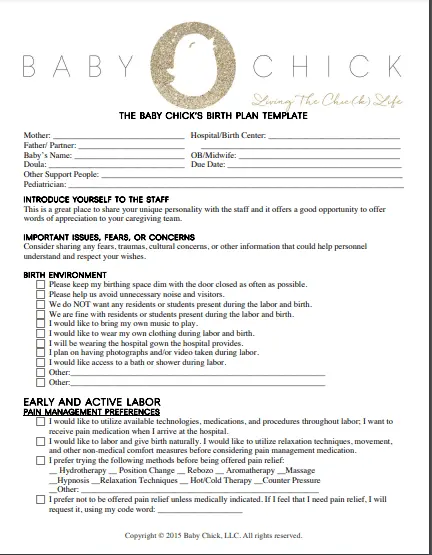
Many of the free, printable birth plans available have parts on pain management with epidurals, desires for C-sections should you require one, and more. They are created with hospital deliveries in mind. With the addition of a NICU plan, this free birth plan form from Baby Chick goes a step further. You may not need it, but you’ll be glad you did if you do. Several options for induction and birth, numerous alternatives for pushing, and significant and careful postpartum considerations not included in other templates, such as whether you’re donating or banking cord blood, are all included.
11. Online Birth Plan Template

Want to create your birth plan online rather than manually filling out several copies? To help with this, Earth Mama Organics offers a free birth-plan tool. You will be required to submit your name and email address, which means you may receive emails from them later. However, if you use the tool, you may feel it is worthwhile. You may identify who you want in your room at different stages of labor, the kind of ambience you want, and your goals for each stage of labor using this birth plan form, which is applicable to both hospital and birth center deliveries.
12. Birth Plan Template For Multiples
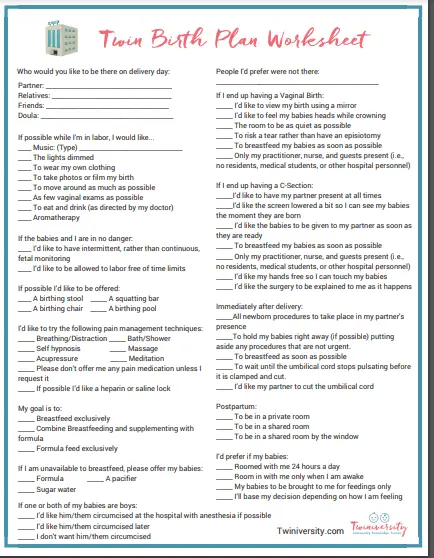
You’ve undoubtedly already observed that the majority of birth plan templates don’t quite fit your delivery if you’re expecting twins or multiples. This Twiniversity template is available for free printing and is entirely dedicated to twins. It contains thorough checklists of choices for labor and pushing as well as preferences for postpartum care. The very best? Check your preferences, print copies for everyone in your care circle, and then carry on.
13. Birth Plan Template For Life-Limiting Conditions
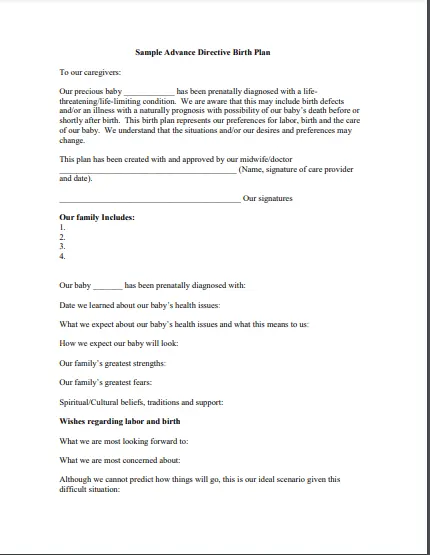
Even though no parent wants to think about losing their child, some couples go into labor and delivery knowing what will happen. Planning their time with their child might seem like one of the most significant things these parents will ever do. Anencephaly.info is a resource website that focuses on a single life-limiting ailment, although any parents in a similar scenario can utilize its birth-plan form. You won’t find this information in the conventional birth plan forms, but it contains room to discuss your spiritual or cultural beliefs, your worries and anxieties, your aspirations for your time with the baby, any medical procedures you want (or don’t), and more.
14. A Birth Plan Template To Help You Prioritize
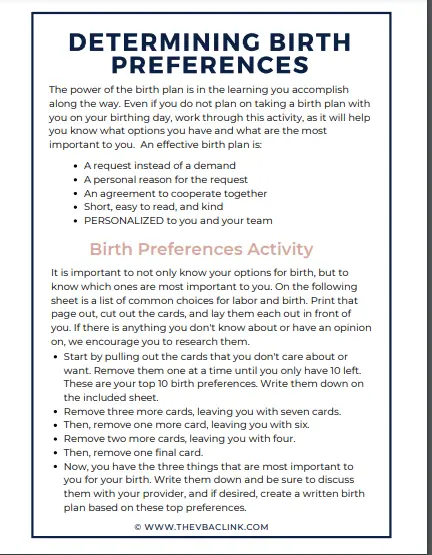
The Determining Birth Preferences Worksheet from The VBAC Link might be useful if you’re attempting to streamline your birth plan or are just trying to determine what’s essential to you. Print out the package, cut off the cards (each of which has a birth plan choice you could have, such as utilizing a birth center), and then just follow the instructions. By the time you’re done, you’ll be able to provide your doctor your top three birth priorities as well as a list of ten other objectives that are significant to you. Enter your email at the bottom of the page after scrolling there to get the PDF.
There is a simple birth plan template available for you, regardless of whether you’re planning a home water birth or a C-section. The template may save you a ton of time by highlighting what was important to the many parents who came before you, whether you use it as-is or as a starting point.
Related: What Does Antenatal Classes Mean?
Create Your Birth Plan Checklist for Parent
